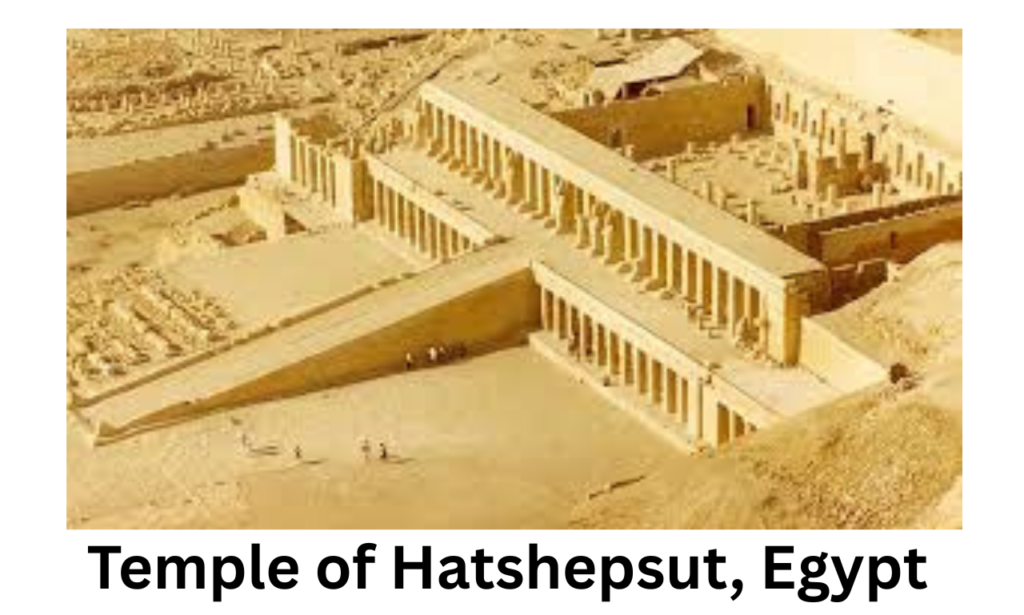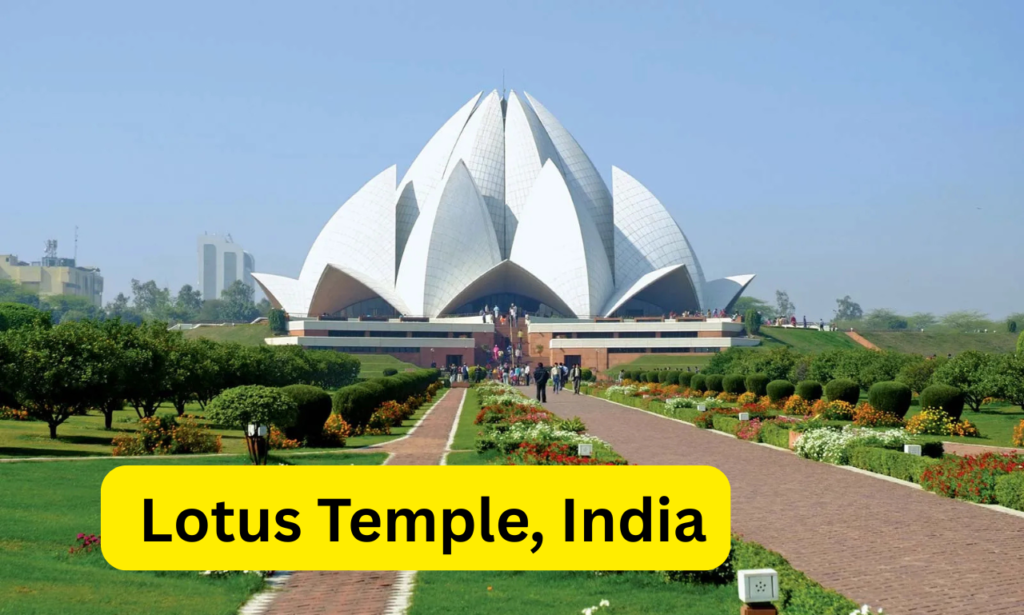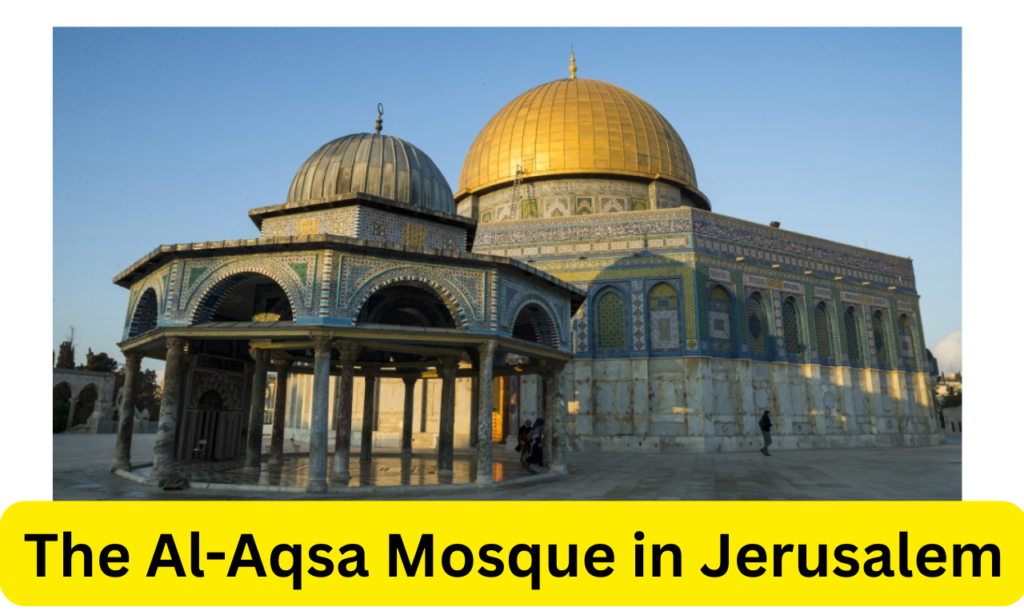
Religious Architectural Marvels: From ancient temples to modern architecture, humanity’s flair for building religious structures showcases our spiritual significance and boundless creative expression. These structures don’t only serve as sites of worship but also as monuments to cultural heritage, brimming with architectural significance and stories that have shaped civilizations.
Whether you’re drawn by the intricate designs or the deep historical context of these masterpieces, these architectural marvels astonish us with their lasting impact on history, culture, and spirituality.
Explore these iconic religious structures from around the world that define architectural prowess and are repositories of a rich history.
Religious Architectural MarvelsNo. 10: Temple of Hatshepsut, Egypt

Located in Egypt’s Deir el-Bahari complex, the Temple of Hatshepsut is a monumental structure carved into limestone cliffs, embodying both architectural innovation and serene elegance. Built during the 15th century, this outstanding piece features terraces, colonnades, and ramps, presenting a stunning example of ancient architectural design.
Dedicated to Amun and Egypt’s first female pharaoh, Hatshepsut, this temple served as a statement of spiritual solace and political strength. Its geometric patterns and carefully structured architectural elements have made it a center of global fascination.
Why It’s Significant
- Represents early examples of structural design and symmetry.
- Tied to Egypt’s narrative of female power and divine endorsement.
The Temple of Hatshepsut is a timeless wonder that sits on the cliffs of Egypt’s Valley of the Kings. This historical wonder honors Queen Hatshepsut, who ruled Egypt about 3,500 years ago and was one of the most interesting pharaohs.
The unique form of this temple fits right in with the natural scenery around it. The temple is built into steep limestone rocks, and its terraced design makes it look like it goes on forever. This is how it got the name “Djeser-Djeseru,” which means “Holy of Holies.”
The Temple of Hatshepsut was a place of prayer and a tomb for the queen. It was dedicated to the sun god Amun-Ra. Its grandeur shows the wealth and power of the New Kingdom era through its detailed reliefs, giant statues, and strong colonnades.
One of the most interesting things about the temple is that it is built on three levels, with rooms and colonnades on each level. The temple’s central axis lines up with the sunrise on the winter solstice, which emphasizes its link to the sky and the future.
The Temple of Hatshepsut is still a great example of old Egyptian engineering and craftsmanship, even though it has been damaged and stolen over the years. Visitors from all over the world are still amazed by its history, which shows the wonders of Egypt’s golden age and Queen Hatshepsut’s rule.
Religious Architectural Marvels No9: Sagrada Familia in Spain

A masterpiece of Spanish architecture, Antoni Gaudí’s La Sagrada Família in Barcelona is an unfinished yet breathtaking Christian cathedral. With its rich Gothic and Art Nouveau architectural language, it features intricate façades like the Nativity and the Passion façade, symbolizing biblical tales in three-dimensional storytelling.
This iconic marvel has enchanted millions since its foundation in the 19th century, and it remains one of the world’s most visited religious buildings examples.
Why It’s Significant
- Breaks boundaries in architectural designs with organic and spiritual motifs.
- A timeless symbol of faith and Gaudí’s visionary architectural spirit.
Antoni Gaudí designed La Sagrada Familia in Barcelona, Spain. It speaks to the lasting spirit of the Catholic faith. This impressive church is a work of art that has been being built for more than one hundred years. Yes, you read that right. It has been planned since 1882.
Gaudí put his whole heart and soul into La Sagrada Familia, giving it his own unique style of architecture by mixing Gothic and Art Nouveau elements. As a result? A unique mix of facades, towers, and stained glass that fills the inside with color.
La Sagrada Familia is still being built, even though it is very well known. “My client is not in a hurry,” Gaudí famously said about God. So, it’s not a surprise that work is still being done on it today. The money for it comes from gifts and ticket sales from millions of people who come to see how beautiful it is.
La Sagrada Familia is the world’s most prominent Roman Catholic church. Its name comes from the fact that it is dedicated to the Holy Family, an important figure for all Catholics.
Religious Architectural Marvels No8: The Hagia Sophia in Turkey

Built in the 6th century under Byzantine Emperor Justinian, Hagia Sophia embodies Islamic and Byzantine design, as it transitioned between a church, mosque, and museum over centuries. The intricate mosaics and Islamic elements, including its domes and seraphim imagery, captivate visitors globally.
Its designation as a UNESCO World Heritage Site reflects its cultural significance and religious symbolism, making it an enduring piece of architectural heritage.
Why It’s Significant
- Serves as a testament to historical changes in religious identities.
- Known for blending Islamic and Christian architectural elements, setting a benchmark for future sacred designs.
It’s not just because it’s been around for more than 1,500 years that Hagia Sophia in Turkey is the most famous building in the world. It has been a church, a mosque, and a museum. Talk about a person who can change with the times.
This fantastic building is in Istanbul and shows how brilliant Byzantine and Ottoman architects were. In the year 537, the Byzantine Emperor Justinian I built it. For more than 900 years, it was an Eastern Orthodox church.
When the Ottomans took over Constantinople, which is now Istanbul, in 1453, they changed Hagia Sophia into a mosque. Tall, thin towers called minarets were added, and Islamic writing and mosaics were used to make the inside look beautiful.
In 1935, Mustafa Kemal Atatürk, who was the first president of Turkey, turned Hagia Sophia into a museum. The place is now a UNESCO World Heritage Site and a mosque again. Hagia Sophia is a mix of Christian and Islamic history, and it stands for religious peace and cultural exchange.
Religious Architectural Marvels No7: Cathedral of Florence, Italy

Built during the 15th century, Florence Cathedral (or the Duomo) in Italy is celebrated for Filippo Brunelleschi’s engineering marvel in dome construction. Its intricate details, Gothic elements, and stunning façade make it one of Italy’s most beloved tourist destinations.
The cathedral stands as a glorious statement of Renaissance humanism and devotion to the Virgin Mary, showcasing how artistic expression can blend with spiritual significance.
Why It’s Significant
- An example of Medieval architecture transitioning to Renaissance ideals.
- Features innovations in dome design are still studied today.
The Florence Cathedral, which is also called the Cathedral of Santa Maria del Fiore, stands tall over the city of Florence like a mighty giant. It is a mix of art, history, and faith. This fantastic piece of architecture shows how creative people were during the Renaissance.
This cathedral is a masterpiece of Gothic design. It took 140 years to build and was finished in 1436. The central dome, which has red tiles and was created by Filippo Brunelleschi, is the most enormous brick dome that has ever been built. It is 376 feet (114.6 meters) tall, which is so huge that it leaves you speechless.
Once you step inside the church, you’ll be struck by how grand it is. Inside, there are paintings and stained glass windows that show off the skill of Renaissance artists. There are also priceless works of art inside the church, such as La Pietà by Michelangelo and the beautiful bell tower by Giotto.
However, the Florence Cathedral is significant to Catholics for religious reasons, not just because of its beauty. Along with being the mother church of the Roman Catholic Archdiocese of Florence, it is named after the Virgin Mary. The beautiful front of the church is decorated with sculptures and marble panels that tell stories from the Bible and represent the path of faith.
Religious Architectural Marvels No Sixth: Lotus Temple, India

A spectacular piece of modern architecture, the Lotus Temple in New Delhi symbolizes unity across faiths and has drawn international attention for its striking features. Designed by Fariborz Sahba in the shape of a lotus flower, the structure offers mesmerizing symmetry and serene simplicity.
This spiritual architectural masterpiece fosters a sense of inclusivity and peace, inviting worshippers of all religions or none.
Why It’s Significant
- Defines innovative design in religious structures.
- Creates a peaceful space for contemplation irrespective of faith.
In the middle of all the noise and chaos in New Delhi, India, there is a peaceful haven called the Lotus Temple. This beautiful piece of architecture stands for peace and unity. The temple is shaped like a lotus flower in bloom. It is home to the Bahá’í Faith, a faith that teaches people are all the same.
A calm feeling greets tourists as soon as they walk inside. The temple’s design is both beautiful and valuable. Its 27 white marble “petals” are set up in perfect order around a prayer hall in the middle that can fit up to 2,500 people.
The Lotus Temple is unique not only because of how it looks but also because it welcomes everyone. Anyone can come in and meditate, no matter what religion they follow or where they come from. All kinds of people from all walks of life gather there to find peace and spiritual renewal.
Since it was built in 1986, the Lotus Temple has become one of the most popular religious places in the world, with millions of tourists and pilgrims going there every year. It is essential for more than just how beautiful it is; it is a symbol of hope and mercy in a world where religious and cultural differences often cause conflict.
Religious Architectural Marvels No5. Angkor Wat in Cambodia

Recognized as a UNESCO World Heritage Site, Angkor Wat in Cambodia is the largest among the world’s religious structures. Built in the 12th century, this iconic Hindu temple was later transformed into a Buddhist center.
Its vast geometric patterns, bas-reliefs, and towering spires make it an unparalleled piece of architectural heritage and cultural identity for Cambodia.
Why It’s Significant
- Showcases the blending of Hindu and Buddhist religious architecture.
- Renowned for its intricate designs and celestial symbolism.
Angkor Wat in Cambodia is a magnificent reminder of how creative and dedicated the Khmer people were in the past. This architectural masterpiece is in the jungles close to Siem Reap. It is a vast complex that covers more than 400 acres, making it the world’s most prominent religious building.
Angkor Wat was built by King Suryavarman II in the early 1100s. At first, it was a temple complex for the Hindu god Vishnu, but it was later turned into a Buddhist temple complex. Its intricate Khmer architecture and symbolic meanings come together in its design. For example, its five towers reflect Mount Meru, which in Hindu and Buddhist mythology is where the gods live.
As people walk through the detailed bas-relief passageways, they are taken back in time and see scenes from Hindu epics like the Mahabharata and the Ramayana. Each carving has a story to tell, showing in unforgettable detail wars, religious ceremonies, and celestial beings.
The way Angkor Wat is aligned with the stars is one of the most interesting things about it. On the spring equinox, the sun rises directly behind the central tower, making a beautiful silhouette against the sky at dawn that draws both believers and tourists.
Religious Architectural Marvels No4. Russia’s St. Basil’s Cathedral

St. Basil’s Cathedral in Moscow remains one of the most beautiful examples of architectural prowess. Built during the reign of Ivan the Terrible, this masterpiece features onion domes, vibrant colors, and patterns that resemble a gleaming bonfire rising toward the sky.
Why It’s Significant
- A symbol of Russian heritage with intricate design capturing history’s decorative charm.
In Moscow, Russia, St. Basil’s Cathedral shows both Russian architecture and holy fervor. This dome-shaped work of art, which is hidden in the famous Red Square, represents Russia’s rich cultural history and deep spiritual roots.
The cathedral of St. Basil was built in the 1600s, during the rule of Ivan the Terrible, to honor the taking of Kazan and Astrakhan. The story goes that Ivan was so amazed by how beautiful the church was that he had the architect, Postnik Yakovlev, blinded so that he could never make anything as beautiful again. It says a lot about how popular the church is, whether it’s true or not.
What makes St. Basil’s stand out is its unique style of architecture, which is shown by its colorful onion domes and complex designs. Every dome stands for a different church. It looks like a mix of various colors and shapes. Inside the church, the frescoes and iconostases are genuinely stunning, taking visitors to a world of religious devotion and artistic mastery.
Even though it’s called St. Basil’s Cathedral, the Russian Orthodox Church celebrates the Protection of the Virgin Mary as a feast day. In the past, it was the main chapel of the Russian tsars. Since then, it has become one of the most famous places in Moscow.
People come to St. Basil’s Cathedral from all over the world, drawn not only by its beautiful architecture but also by the spiritual energy that fills its walls. People who see it are changed by the way history and faith come together there.
Religious Architectural Marvels No3: Chinese Shaolin Temple

Dating back to the 5th century, this monastery is the cradle of Zen Buddhism and Kung Fu. Its architectural elements blend simplicity with spiritual grandeur.
Why It’s Significant
- Known for its martial arts legacy and connection to Zen Buddhism.
The Shaolin Monastery is one of the most famous sacred buildings in all of China. It is a Buddhist temple in the region of Henan that has been around for more than 1,500 years. The temple is not only a place of worship but also a place where people can learn martial arts. People think it’s where Kung Fu got its start.
As early as the fifth century, the Indian monk Bodhidharma opened the Shaolin Monastery. The temple complex was built at the base of the Songshan Mountain range. It has many buildings, such as the main hall, pagodas, and gardens. The Shaolin Monastery is built in a style that is a mix of Indian and Chinese.
For Buddhists who follow the Chan order, the Shaolin Monastery is a significant place. Meditation, prayer, and physical training are all essential to the monks at the temple. They’ve been in a lot of movies and TV shows because of how good they are at martial arts.
The monastery has a long past and has been through a lot of hard times over the years. During the Tang Dynasty, it was a place where many students went to learn. During the Cultural Revolution in the 20th century, it was damaged. It has since been fixed up and is now a UNESCO World Heritage Site.
Religious Architectural Marvels No2: The Al-Aqsa Mosque in Jerusalem

Situated near the Dome of the Rock, Al-Aqsa Mosque is celebrated for its Islamic designs, decorative motifs, and religious significance for Muslims worldwide. This is a monumental structure dating to the 7th century, showcasing early examples of Byzantine architectural features.
Why It’s Significant
- Integral to Jerusalem’s religious identities and a site of spiritual solace.
A fantastic piece of architecture, the Al-Aqsa Mosque is right in the middle of Jerusalem’s Old City. It is one of the holiest places in Islam.
Al-Aqsa is an integral part of Islamic history because it dates back more than a thousand years. For Muslims, it’s the third most excellent place in the world, after Mecca and Medina. For Muslims, this holy place is significant because they think that the Prophet Muhammad went there during the Night Journey.
The mosque is a masterpiece of clever architecture. Its massive complex includes the mosque, grounds, courtyards, and other buildings and covers about 35 acres. The silver dome, which is supported by beautiful arches and pillars, is the most famous building in Jerusalem’s Old City.
In its very long past, Al-Aqsa has seen many empires rise and fall, been through many wars, and has always been a symbol of strength and devotion. People from all walks of life come to see its beauty and feel its spiritual energy, so it’s not just important to religious people.
Religious Architectural Marvels No1: Thailand’s Wat Rong Khun Island

Also referred to as the White Temple, this exquisite Thai structure is one of the most recognizable religious buildings in the world. Its dazzling, intricate façade, filled with symbolic imagery, sets it apart as both a spiritualarchitecturalt marvel and an artistic expression of its time.
Why It’s Significant
- Combines ancient Thai design with modern architectural aesthetics and symbolism.
Wat Rong Khun, also called the “White Temple,” is a beautiful holy building in Chiang Rai, Thailand. Even though the temple isn’t ancient, its unique design has made it one of the most famous places for tourists to visit in Thailand.
The temple was built by the artist Chalermchai Kositpipat, and it became open to the public in 1997. It’s a Buddhist temple, but it doesn’t look like any other temple in Thailand. There are tiny mirrors all over the building, which make it sparkle in the sun. The building is made white to represent how pure Buddha is.
The bridge that leads to the main door of the temple is one of its most interesting features. As the name suggests, the bridge is the “Bridge of the Cycle of Rebirth.” It shows the way from the cycle of rebirth to knowledge.
Inside the temple, there are detailed paintings that show the battle between good and evil. Modern art styles are used to paint the panels, which have pictures of Superman, Batman, and other famous people from pop culture. These paintings are meant to show that the battle between good and evil is still going on today.
Related: Safest Large Cities in America for Families (Top 10)
Discover the Spiritual and Architectural Wonders
Religious structures are so much more than spaces for prayer; they’ve been vessels of culture, genius, and human creativity for centuries. These architectural marvels not only commemorate faith but also celebrate architectural significance and design innovation.
If you’ve been inspired by their historical narrative, consider making a pilgrimage to witness humanity’s most significant expressions of art, culture, and faith firsthand.



